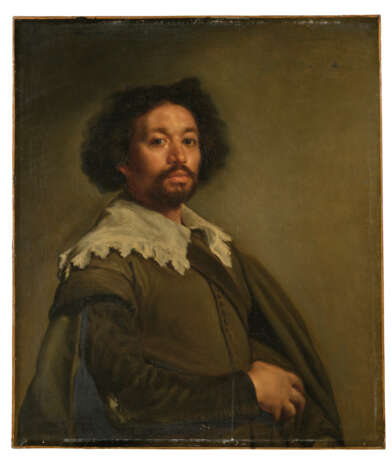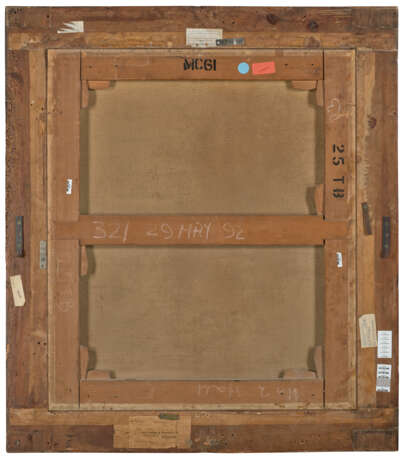ID 1336082
Lot 25 | ÉCOLE ITALIENNE VERS 1700, D'APRÈS DIEGO RODRIGUEZ DE SILVA Y VELÁZQUEZ
Valeur estimée
€ 20 000 – 30 000
Portrait de Juan de Pareja (vers 1606-1670), à mi-corps
huile sur toile
82 x 70 cm (32 ¼ x 27 ½ in.)
Provenance
Lt.-Gen. William Stewart Balfour (1800-1869), Arbigland, Kirkbean, Dumfries, Écosse ;
Puis par descendance avec la maison à son petit-neveu, Colonel Christopher Edward Blackett (1864-1904) ;
Puis par descendance à Captain J. B. Blackett (1939-2019), Londres ; vente anonyme, Christie's, Londres, 29 mai 1992, lot 321 (comme entourage de Diego Rodriguez de Silva y Velázquez) ;
Acquis au cours de celle-ci par l’actuel propriétaire.
Literature
N. J. Little, 'Old Master Copies Continue to Challenge Experts', IFAR reports and The Art Loss Register, juin 1993, 14, VI, p. 3.
H. von Sonnenburg, 'A Note on the Dimensions of Juan de Pareja', The Metropolitan Museum of Art Bulletin, hiver 1993-1994, 51, III, p. 31, reproduit en noir et blanc p. 28, fig. 4.
Further details
ITALIAN SCHOOL CIRCA 1700, AFTER DIEGO RODRIGUEZ DE SILVA Y VELÁZQUEZ, PORTRAIT OF JUAN DE PAREJA, HALF-LENGTH, OIL ON CANVAS
In 1649, Diego Velázquez (1599-1660), the court painter to King Philip IV of Spain (1605-1665), set off on a mission to Rome to buy Italian works for the Alcázar in Madrid. His travelling companion was his slave and disciple Juan de Pareja (c. 1610-1670), who he freed in 1654. During his stay in Rome, Velázquez was commissioned to paint the portrait of Pope Innocent X (1574-1655), a member of the great patrician family, the Pamphili. In the first biography of the Spanish painter, Antonio Palomino (1655-1726), explained that once Velázquez had decided to paint such an important portrait, he wanted to first practise painting from life, and took Pareja as his model.
The resulting portrait, which was only supposed to be a preparatory work, met with extraordinary success when it was exhibited at the Pantheon in March 1650. After the departure of Velázquez and Pareja, the painting remained in the Eternal City; it 1704 it was exhibited in the church of San Salvatore in Lauro, when it was described as belonging to Cardinal Tommaso Ruffo (1663-1753). The painting is currently held in the Metropolitan Museum in New York (inv. no. 1971.86) and is considered one of the museum's highlights.
The present version of the portrait is the work of an Italian artist and dates from the late seventeenth or early eighteenth century, perhaps even from the time of its exhibition in 1704. There are two specific clues as to the origins of this painting. The first is the use of genuine ultramarine, traces of which were identified in the skin tones when the painting was examined in 1992 in the laboratories of University College London. This pigment, almost never found in Spanish painting of the period, was often used in Italy. The technique whereby the artist shaded skin tones with ultramarine can already be observed in sixteenth century works by pioneering artists such as Titian (circa 1488/1490-1576).
The second clue is the size of our painting. After acquiring Velázquez's original painting in 1971, the Met discovered that the canvas had been folded, most likely in the 19th century when it formed part of the collection of the Earls of Radnor in England. This act had the effect of centring the model on the canvas. It was later discovered that the copy of the portrait belonging to the Hispanic Society of America in New York, previously considered to be the most faithful to the original, used the dimensions of the folded portrait, thus dating it from a later period in the history of the original painting. However, the present portrait follows the original dimensions of the portrait, which means that it was painted before it went to England. As far as we know, this is the only copy of the painting that corresponds exactly to the dimensions of Velázquez's work (see H. von Sonnenburg, 1993-1994, op. cit. above). It may be the earliest copy of the work that exists.
| Technique appliquée: | Huile sur toile |
|---|---|
| Style artistique: | Vieux Maître |
| Genre: | Portrait |
| Lieu d'origine: | Italie, Europe |
| Catégorie maison de vente aux enchères: | Peintures, Aquarelles, Dessins, Peintures |
| Technique appliquée: | Huile sur toile |
|---|---|
| Style artistique: | Vieux Maître |
| Genre: | Portrait |
| Lieu d'origine: | Italie, Europe |
| Catégorie maison de vente aux enchères: | Peintures, Aquarelles, Dessins, Peintures |
| Adresse de l'enchère |
CHRISTIE'S 8 King Street, St. James's SW1Y 6QT London Royaume-Uni | |
|---|---|---|
| Aperçu |
| |
| Téléphone | +44 (0)20 7839 9060 | |
| Commission | see on Website | |
| Conditions d'utilisation | Conditions d'utilisation |




